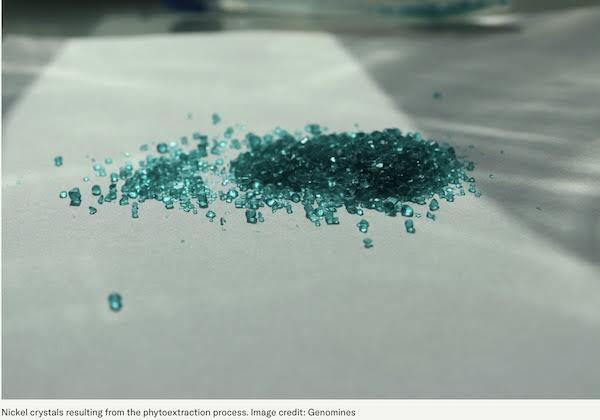Amid the rolling wildflower fields of South Africa, a profound disruption is underway in the world of mining, a sector not typically known for its gentleness on the land. What looks like a sea of yellow daisies is actually the launch site of Genomines, a pioneering biotech startup leveraging gene-edited plants to mine nickel, a metal vital for our energy transition and modern infrastructure. Instead of the usual image of mining, explosives gouging into the earth and terraced pits marring the landscape, Genomines practices “phytomining,” deploying hyperaccumulator plants that naturally absorb metals from the soil and concentrate them throughout their stems and leaves.
Genomines uses advanced genetic engineering and synthetic biology to enhance what are known as “hyperaccumulator” plants. Hyperaccumulators are unusual plants that naturally absorb and accumulate high concentrations of specific metals, such as nickel, cadmium, or arsenic, in their above-ground tissues without suffering toxic effects. Of the 350,000 known plant species, just 750 fall into this category, including some species of rapeseed and pennycress, sunflowers, and daisies.
At the core of Genomines’ innovation is the manipulation of a wild daisy species hardwired for survival in metal-rich environments. These daisies, by virtue of their evolved metabolism, are able to extract nickel from soils in concentrations that would quickly poison ordinary crops. Genomines has taken a step further by gene-editing the daisies, making them three times larger and doubling their metal absorption capability. The results are staggering, with up to 7.6% nickel content within plant biomass, versus concentrations that have historically been too low to make commercial extraction feasible.
This solution is timely, given the mounting pressures on traditional mining supply chains. Nickel, prized for its critical role in batteries and stainless steel, is becoming harder to source. The majority of the world’s supply is now concentrated in Indonesia, with Chinese-financed mines dominating production. High-grade reserves are forecasted to deplete before the decade’s end, and even lower-grade ore, crucial for battery manufacturing, may run dry by mid-century. The threat of bottlenecks and geopolitical risk grows ever more acute as competition intensifies for these finite resources.
The Genomines approach offers a radically different, sustainable, and geographically diversified solution. Their pilot site sits atop South African land where the soils are so enriched, or contaminated, with nickel that conventional agriculture is impossible. Yet it is perfect for phytomining. Crops are grown for four to six months, absorbing the metal. Harvesting the plants yields the vital raw material, which is extracted as battery-grade nickel oxide after drying and heating. There is minimal infrastructure to build, no need for vast fleets of trucks or years of exploratory drilling. Indeed, Genomines estimates it can start new operations in just one to two years, far faster than the decade or longer usually required for establishing traditional mines.
Energy efficiency is a key differentiator for Genomines. The agricultural model reduces total energy consumption, resulting in lower capital and operational expenditures. Since the daisies also sequester atmospheric carbon during growth, the process is inherently carbon neutral. There’s an added environmental bonus, rather than degrading land and creating toxic tailings, the plants actually remediate contaminated fields, transforming once-toxic sites into productive, safe terrain. The scale and flexibility are such that Genomines predicts over 74 million acres worldwide could support this approach, with the potential to yield 7 to 14 times as much nickel as the entirety of today’s mining operations.
By turning marginal land into productive bio-mines, Genomines says it can achieve commercial yields in just 1–2 years—a huge contrast to the 12–17 years required for developing traditional mines. Growing plants also requires substantially less infrastructure than carving out a new mine. These mines, which are the “size of small cities,” according to Koutchekian, also extract just tiny fractions of metal from the tons of rock they excavate. According to Dave McNear, a rhizosphere biogeochemist at the University of Kentucky, “In soil that contains roughly 5% nickel—that is pretty contaminated—you’re going to get an ash that’s about 25 to 50 percent nickel after you burn it down. In comparison, where you mine it from the ground, from rock, that has about .02 percent nickel. So you are several orders of magnitude greater in enrichment, and it has far less impurities.” Genomines claims to reduce costs for nickel and metal extraction by 40–50% compared to conventional mining, primarily through energy cost savings. The company expects to produce nickel oxide at around $10,000 per ton, versus an industry median of around $16,000 per ton. This battery-grade nickel is essential for electric vehicles and renewable technologies. A round led by Engine Ventures equips the company for aggressive expansion, with multiple pilot sites underway across three continents.
As CleanTech accelerates the electrification of everything, Genomines is at the vanguard of a new metals era, one that promises not only resource abundance but true circularity and restoration. While nickel is the current focus, the technology is adaptable to other critical metals, hinting at future disruption across the entire spectrum of battery and infrastructure supply chains. In the words of cofounder Koutchekian, the mission is to not just reduce the footprint of mining, but remap where and how minerals are sourced, democratizing access and decoupling metal supply from unsustainable practices. Learn more about Genomines HERE. (Source: FastCompany, Agfundernews, YahooFinance, Axios, Wired, Deutsche Welle)









